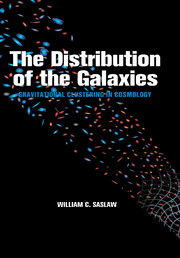Book contents
- Frontmatter
- Contents
- Prologue
- Part I Historical
- Part II Descriptions of Clustering
- Part III Gravity and Correlation Functions
- Part IV Gravity and Distribution Functions
- Part V Computer Experiments for Distribution Functions
- Part VI Observations of Distribution Functions
- Part VII Future Unfoldings
- Bibliography
- Index
Part V - Computer Experiments for Distribution Functions
Published online by Cambridge University Press: 19 January 2010
- Frontmatter
- Contents
- Prologue
- Part I Historical
- Part II Descriptions of Clustering
- Part III Gravity and Correlation Functions
- Part IV Gravity and Distribution Functions
- Part V Computer Experiments for Distribution Functions
- Part VI Observations of Distribution Functions
- Part VII Future Unfoldings
- Bibliography
- Index
Summary
Many motives spur astronomers toward numerical simulations. These computer experiments test well-defined theories, display outcomes of complex interactions, elicit quantitative comparisons with observations, and provoke new insights. Moreover, they are almost always guaranteed to lead to a publishable result. What could be finer and more delightful!?
Streams of simulations have therefore poured forth in abundance. They differ mainly in their assumptions about the amount, nature, and role of dark matter, and in their initial conditions. Most agree with some aspects of observations, but none with all. None, so far, are generally accepted as complete descriptions of galaxy clustering.
As computing power expands, each new generation essentially repeats these simulations with more complicated physical interactions, greater detail, higher resolution, and added parameters. While this development continues, it seems to me wiser not to discuss the latest examples here, for they will soon be as obsolete as their predecessors. Instead, we concentrate on the simplest case: the cosmological many-body problem. Even this reveals a richness of behavior that surpasses current understanding. Understanding is more than simulation, for it embeds the simulations in a much richer conceptual context.
- Type
- Chapter
- Information
- The Distribution of the GalaxiesGravitational Clustering in Cosmology, pp. 387 - 388Publisher: Cambridge University PressPrint publication year: 1999



